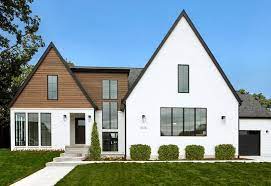Exploring the Timeless Charm of Cottage Architecture

The Charm of Cottage Architecture
Cottage architecture holds a special place in the hearts of many homeowners and architects alike. Known for its cozy and quaint appeal, cottage-style homes exude warmth, charm, and a sense of nostalgia.
Characterized by their small size, asymmetrical design, steep roofs, and intricate detailing, cottages often feature elements such as exposed beams, decorative trusses, and cozy fireplaces. These homes are typically built with natural materials like wood and stone to blend harmoniously with the surrounding landscape.
One of the defining features of cottage architecture is its emphasis on creating a welcoming and comfortable living space. The interior of a cottage is usually designed to be cozy and inviting, with an open floor plan that maximizes space and natural light. Large windows offer picturesque views of the outdoors, bringing nature indoors.
Whether nestled in the countryside or along the coast, cottage-style homes are versatile and adaptable to various settings. From charming beach cottages with weathered shingles to rustic mountain retreats with exposed timber framing, each cottage tells a unique story through its design.
While traditional cottage architecture draws inspiration from historic English, French, or American styles, modern interpretations have emerged that blend classic elements with contemporary touches. These updated cottages often feature sleek lines, minimalist interiors, and sustainable building practices.
Overall, cottage architecture continues to captivate homeowners seeking a retreat from the hustle and bustle of modern life. Whether you’re drawn to the timeless appeal of a classic cottage or prefer a more modern twist on this beloved style, there’s no denying the enduring charm and allure of cottage architecture.
Exploring Cottage Architecture: Size Standards, Style Characteristics, and Defining Differences from Houses
- What is the ideal size of a cottage?
- What is considered cottage style?
- What makes a cottage a cottage and not a house?
- What is cottage style architecture?
What is the ideal size of a cottage?
When considering the ideal size of a cottage, it ultimately depends on individual preferences, needs, and the intended use of the space. Cottages are typically known for their cozy and intimate atmosphere, making them perfect for small families, couples, or individuals looking for a retreat away from the city. While there is no strict rule on size, most cottages range from around 800 to 1,500 square feet to maintain that charming and quaint feel. However, some may opt for larger cottages with additional bedrooms or living spaces for hosting guests or accommodating specific lifestyle requirements. Ultimately, the ideal size of a cottage is subjective and should align with the desired functionality and comfort level of its inhabitants.
What is considered cottage style?
Cottage style architecture is characterized by its cozy and charming aesthetic, drawing inspiration from traditional English, French, or American designs. Elements commonly associated with cottage style include small size, asymmetrical layouts, steep roofs, and intricate detailing like exposed beams and decorative trusses. Natural materials such as wood and stone are often used to create a warm and inviting atmosphere. Cottage interiors are designed to be comfortable and welcoming, with open floor plans that maximize space and natural light. Large windows offer picturesque views of the surrounding landscape, blurring the lines between indoor and outdoor living spaces. Whether nestled in the countryside or along the coast, cottage-style homes evoke a sense of nostalgia and tranquility, making them a popular choice for those seeking a retreat from modern life.
What makes a cottage a cottage and not a house?
When distinguishing between a cottage and a house, the defining characteristics lie in the size, style, and overall ambiance of the structure. A cottage is typically smaller in size compared to a traditional house, emphasizing coziness and intimacy over grandeur. Cottages often feature charming details such as steep roofs, asymmetrical designs, and quaint architectural elements that exude a sense of warmth and nostalgia. Additionally, cottages are often associated with rural or seaside settings, embracing a more relaxed and casual lifestyle. Ultimately, what sets a cottage apart from a house is its ability to evoke feelings of comfort, simplicity, and a connection to nature that transcends mere physical dimensions.
What is cottage style architecture?
Cottage style architecture is a charming and cozy design aesthetic that embodies a sense of warmth and nostalgia. Typically characterized by its small size, asymmetrical layout, and intricate detailing, cottage architecture often features elements such as steep roofs, exposed beams, and natural materials like wood and stone. The interior of a cottage-style home is designed to be inviting and comfortable, with open floor plans that maximize space and natural light. Whether nestled in the countryside or by the coast, cottage-style homes offer a retreat from the fast-paced modern world, creating a tranquil and picturesque living environment that captures the essence of simplicity and relaxation.
